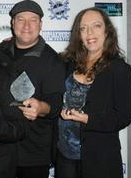Pearl Harbor

Jim Landis and Adriane Coros
In the 1941 attack on Pearl Harbor, the warship USS West Virginia sustained six torpedo hits and two bomb blasts. Over 100 men died on board. Seventy sailors were trapped below decks, never to be found until the ship was raised from the harbor bottom six months later.
Two seasoned screenwriters, Adriane Coros and Jim Landis, developed the award-winning Dog It Down, a story about several men trapped in a storeroom on the ship. “It was a heartbreaking and little known story,” Coros says, “that needed to be told. It’s not about the larger picture of World War II, it’s an intimate story of three men facing death in unimaginable circumstances.”
INT. STOREROOM – DAY 9 – DECEMBER 15
AARON, his arm in a make shift sling, is awkwardly dealing out poker hands. He drops a card. Without comment IOWA picks up the Ace of Spades, wipes off a smear of blood and adds it to one of the hands.
“The story is about courage and human adversity,” says Landis. “What do you reach for in yourself, when all seems lost.”
Coros stumbled on the story a number of years ago. “No matter how involved we were in other scripts,” says Coros, “these three young sailors just wouldn’t go away – haunting indeed. Finally (director Mark Haapala) approached us with the idea of producing a short film based on a script we would write. We knew this was it – this was the moment to explore the story!”
Writing the Script

Poster for Dog It Down
The two writers approached the story with sensitivity. “With limited information on the actual men that perished,” says Coros, “and no realistic way of researching any family or friends that knew them, we made the choice to create three fictional characters and put them in this very real event. We also were cognizant that we did not want to mischaracterize these very real heroes, or offend any possible living relatives with our script. We wanted to honor them by telling the story of what they endured, and how the human spirit can triumph even in the darkest hours.”
The writers struggled to get inside the hearts of the three sailors. “We had to ask ourselves – what did they think about during those endlessly long days and nights waiting for rescue? What did they talk about? Did they know each other or were they strangers? How did they face their inevitable end?”
“But these men,” Coros says, “could not escape the reality of their own impending death. And they lived with that truth for many days, far from their loved ones… so far from home.”
Writing a Short Script
Coros states that writing a short film script can often be more difficult. “You have to be very clear about every single moment, every single line. You don’t have the luxury of long scenes. You can’t slowly flesh out the characters.”
“Conversely,” she adds, “writing a short script is actually easier for the very same reasons. Writing lean pushes you to really understand exactly what you are trying to say in each and every scene, each and every line, and to know your characters thoroughly. And being that clear allows the writing to flow and yet stay focused.
“Jim and I have a tendency to write a little long on scripts, so this was a great challenge for us. Yet it was also one of the easiest scripts we’ve ever written. Once we got through the many, many hours of research, the actual writing flew by. We stayed so focused and were so clear on our characters and on what we wanted to create that we did very little re-writing.
“Because of the limits of time in a short film and the limits of budget, we made the decision to focus solely on the three men inside the ship. We felt it didn’t need scenes of the attack on Pearl Harbor, or their loved ones, or the Navy trying to rescue them.”

Three sailors
The writers wanted to add a few scenes of the men the night before the attack. “We saw a photo one of the real sailors had taken with some friends at The Monkey Bar the night before, and it was such a happy moment captured on film, no foreshadowing of how his life would change in only a few hours.
“But with our time constraints (and tiny budget),” says Coros, “we couldn’t have the luxury of those scenes without losing precious time later in the film. These are the kinds of choices you have to make in a short film script.”
Producing Their Own Script
Landis has been in the TV and film business since 1986. “I’ve written a lot of scripts both with Adriane and without. What I have learned was I got tired and fed up with waiting for others’ approval to follow your passion.” He says the timing was just right on this project. “Director Mark Haapala was looking for something to direct. Mark and I had met on the set of HBO’s Entourage, and became fast friends. So Mark, Adriane and I started talking and the next thing you know, we are in pre-production”
Landis has worked as a prop master on many projects. “In the past,” he says, “(that) had played against me in getting anyone to consider me a real writer, but now being from the crew was a huge asset. It gave me the insight and know-how to produce.”
“We were the little film that could,” he says. “Daily it kept growing and A-list crew members were coming out of the woodwork to be part of this little film. Some wanted to honor their grandfathers who were there in 1941, others just thought they were part of something special…and it was.”

Award for Best Short Film
“To the young film makers,” Landis says, “JUST DO IT!!! Don’t talk about it, don’t brag about it, just do good work. And you script writers, remember the hardest thing to do is write ‘The End’. Get your words on the page and move forward with your script. Stop self-editing until you have something to edit!”
Coros’ advice for writers: “Love your subject, you’ll be spending a lot of time together. And if you are considering producing the film yourselves be aware of costs in your re-writes. Sometimes a small change can make a huge savings in the budget without sacrificing your vision. Accept that there may be some scenes/lines/moments lost. We had a few cuts we had to make because we were simply running out of time at our location. It happens.
“And finally, if you are the writer but not the producer and/or director, remember it’s a collaborative art and you have little control once the shooting starts. But everyone involved wants it to be wonderful, so let the others do what they do so well.”
Coros says, “One important issue we had to deal with was an extremely short shooting schedule. We had two days to film a 28-minute short (it was later cut down in editing to 22 minutes). So with no time to lose, having a talented and professional cast and crew was key. A shared vision and/or passion for the story doesn’t hurt either.”
Casting
Coros says, “Since I had little to do with the producing end, I can mainly speak about the actors. In my nearly 20 years producing and directing in the theatre I learned early on that casting is probably the most crucial decision you will make. It’s the same with film. If you choose wisely, you can let them do their job, while everyone else focuses on their own work. If you choose poorly, the director will likely also have to take on the role of acting coach, therapist and/or referee. The writer may be forced to change lines and adjust scenes because they just aren’t convincing enough with what you originally wrote. The editors will have double the work trying to find their best scenes.
“So why go there?” she says. “Take your time with casting. In our case the actors were a dream to work with. As our director pointed out, he never once had to re-shoot a single moment because the actors forgot a line or lost focus. They were ready on take one!”
Coros continues, “Certainly as a writer we always have an image in our minds of the actors we want for each role. One piece of advice, always choose talent over the ‘look’ you want. If you can get both, bravo, but if you have one actor who looks perfect for the part, but doesn’t quite bring the acting chops you need, and you have another actor who knocks it out of the park, but perhaps is not physically exactly right – go with the better actor! Always.”
Choosing Crew
One factor Coros considers critical in choosing cast and crew is temperament. “This is not brain surgery, it’s film making, so why not have the process be a positive, enriching experience for everyone? We were blessed with a fantastically talented and hugely supportive crew. Even after spending two days buried deep in the dark and dirty bowels of a WWII ship everyone was still excited and positive. I never heard one grumble or one complaint. I never heard anyone angry or frustrated. Every single person involved with Dog It Down just wanted to make the very best film we could… to tell the story of these three young men. And for that I’ll always be grateful.”
Landis says, “The hardest part was asking people to work for free. We were lucky, they came willing. I will never forget that. Ever! We were blessed and honored to have the cast and crew we did.”
Landis offers a last word of advice. “They say this business is hard…it is. They say it’s who you know…maybe. They say you’ll never make it….BULLSHIT!”
(Top photo credit: Jeff Gritchen, Press-Telegraph, Long Beach)
Brief bios for Adriane Coros and Jim Landis.
